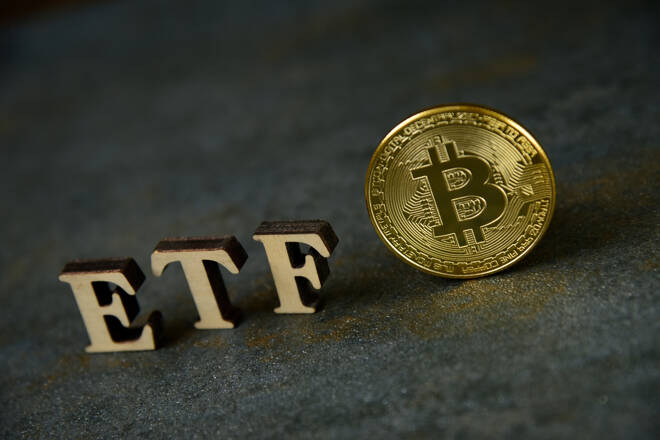Advertisement
Advertisement
Bitcoin News Today: BTC-Spot ETFs See Net Inflows for Four Consecutive Days
By:
On Friday, BTC-spot ETF-relate news will continue to influence buyer demand for BTC. However, the US Jobs Report also needs consideration.
Key Insights:
- BTC gained 1.25% on Thursday, ending the session at $43,111.
- The BTC-spot ETF market registered a fourth consecutive day of inflows as GBTC outflows trended lower.
- On Friday, BTC-spot ETF-related updates from days 15 and 16 of trading, US lawmaker chatter, and the US Jobs Report need consideration.
BTC-Spot ETF Market Logs a Fourth Consecutive Day of Inflows
BTC gained 1.25% on Thursday. Reversing a 0.93% loss from Wednesday, BTC ended the Thursday session at $43,111.
The BTC-spot ETF market logged a fourth consecutive day of inflows on Wednesday. Bloomberg Intelligence ETF analyst James Seyffart shared the stats for day 14 of trading, saying,
“Update for the Bitcoin ETF Cointucky Derby as of Jan 31. Another net inflow day of near $200 million. Total net inflows of $1.46 billion since launch.”
Significantly, Fidelity Wise Origin Bitcoin Fund (FBTC) topped the flow rankings, with net inflows of $232.1 million on Day 14. iShares Bitcoin Trust (IBIT) saw net inflows of just $116.2 million despite recording higher trading volumes than FBTC.
However, since launch, IBIT had total net inflows of $2,787.2 million versus $2,485.4 million for FBTC. The BTC-spot ETF market saw net inflows of $1,460.0 million since launch, even though GBTC had net outflows of $5,641.2 million.
BTC and the broader crypto market remained sensitive to BTC-spot ETF data despite the recent warnings that the BTC-spot ETF market is not the entire BTC market.
IBIT net inflows were down as BlackRock (BLK) started a new ad campaign to lure investors.
While the focus remains on IBIT and FBTC, two other BTC-spot ETFs are seeing positive trends. ETF Institute co-founder Nate Geraci noted that four BTC-spot ETFs recorded 14 consecutive days of net BTC inflows. The four spot ETFs were iShares Bitcoin Trust (IBIT), Fidelity Wise Origin Bitcoin Fund (FBTC), ARK 21Shares Bitcoin ETF (ARKB), and Bitwise Bitcoin ETF (BITB).
Grayscale Bitcoin Trust (GBTC) recorded 14 consecutive days of net outflows.
BitMEX Research Shares GBTC Numbers for Day 15 of Trading
BitMEX Research shared GBTC stats for Day 15 of trading (01/02/24). Significantly, GBTC net outflows declined from $188 million (Day 14) to $182 million (Day 15). Outflows remained well below $640.5 million of net outflows on Day 7 of trading.
A continued downward trend in GBTC outflows remains a positive BTC price signal.
However, US economic indicators could influence investor sentiment later today.
Bitcoin and the US Jobs Report
On Friday, the US Jobs Report will likely garner investor interest. BTC and the broader market ended Wednesday with losses as investors reacted to the more hawkish-than-expected FOMC Press Conference.
BTC recovered from session lows on Thursday, with weaker-than-expected US labor market data raising bets on a March Fed rate cut.
The US Jobs Report could materially influence the Fed rate path and the appetite for riskier assets. Softer-than-expected US wage growth numbers and a larger-than-forecast rise in the US unemployment rate could drive demand for riskier assets. Economists forecast average hourly earnings to increase by 0.3% in January and for the US unemployment rate to rise from 3.7% to 3.8%.
Technical Analysis
Bitcoin Analysis
BTC hovered above the 50-day and 200-day EMAs, affirming bullish price signals.
A BTC return to the $43,500 handle would give the bulls a run at the $44,690 resistance level.
On Friday, BTC-spot ETF market net flow data for Day 15 and the US Jobs Report need consideration.
However, a break below the $42,968 support level would bring the 50-day EMA into play. A drop below the 50-day EMA would give the bears a run at the $39,861 support level.
The 14-Daily RSI reading, 54.26, suggests a BTC rise to the $44,690 resistance level before entering overbought territory.
Ethereum Analysis
ETH held above the 50-day and 200-day EMAs. The EMAs sent bullish price signals.
An ETH breakout from $2,350 would support a move to the $2,457 resistance level.
ETH-spot ETF-related news needs investor consideration.
However, an ETH fall through the 50-day EMA and $2,300 support level would give the bears a run at the $2,143 support level.
The 14-period Daily RSI at 47.20 indicates an ETH drop to the $2,143 support level before entering oversold territory.
About the Author
Bob Masonauthor
With over 28 years of experience in the financial industry, Bob has worked with various global rating agencies and multinational banks. Currently he is covering currencies, commodities, alternative asset classes and global equities, focusing mostly on European and Asian markets.
Did you find this article useful?
Latest news and analysis
Advertisement
